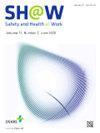Work Exposome and Related Disorders of Firefighters: An Overview of Systematized Reviews
IF 2.9
3区 医学
Q1 PUBLIC, ENVIRONMENTAL & OCCUPATIONAL HEALTH
引用次数: 0
Abstract
Introduction
Firefighters experience many exposures associated with negative health outcomes. Because of this, there are many studies on the subject. Our objective here was to conduct an umbrella review of systematized reviews to identify firefighting activities and related exposures associated with negative health outcomes.
Methods
A comprehensive search of the PubMed, Web of Science, and Scopus (Health) was conducted using all firefighter systematized reviews. We extracted the country and date of the review, type of firefighter, types of exposure, and related health outcomes. Risk of bias was based on AMSTAR-2 checklist.
Results
In 1130 studies, 47 systematized reviews were included, mostly in the last 5 years and from North America and Australia. The topics were diverse, ranging from general aspects to specific exposures, such as polycyclic aromatic hydrocarbons, wildland fires, organizational, traumatic, or psychological stress exposure, and from prevention or surveillance to specific health effects (e.g., cancer, mental health, musculoskeletal disorders, cardiovascular, and pulmonary health, etc.). The risk of bias assessment using the selection grid shows a significant heterogeneity, though some studies were of very high quality.
Discussion
This umbrella review provides a comprehensive description of systematized reviews describing populations of firefighters, including information on exposure, health outcomes, and illness/injury prevention.
消防员的工作暴露和相关疾病:系统化综述
消防员经历了许多与负面健康结果相关的暴露。正因为如此,有很多关于这个主题的研究。我们的目标是对系统化审查进行总括性审查,以确定与负面健康结果相关的消防活动和相关暴露。方法综合检索PubMed、Web of Science和Scopus (Health),采用所有消防系统综述。我们提取了审查的国家和日期、消防员类型、暴露类型和相关的健康结果。偏倚风险基于AMSTAR-2检查表。结果共纳入1130项研究,47项系统评价,主要来自北美和澳大利亚,研究时间近5年。主题多种多样,从一般方面到具体暴露,如多环芳烃、野火、组织、创伤或心理压力暴露,从预防或监测到具体的健康影响(如癌症、精神健康、肌肉骨骼疾病、心血管和肺部健康等)。使用选择网格的偏倚风险评估显示出显著的异质性,尽管一些研究的质量非常高。本总括性综述提供了对描述消防员人群的系统化综述的全面描述,包括暴露、健康结果和疾病/伤害预防方面的信息。
本文章由计算机程序翻译,如有差异,请以英文原文为准。
求助全文
约1分钟内获得全文
求助全文
来源期刊

Safety and Health at Work
Social Sciences-Safety Research
CiteScore
6.40
自引率
5.70%
发文量
1080
审稿时长
38 days
期刊介绍:
Safety and Health at Work (SH@W) is an international, peer-reviewed, interdisciplinary journal published quarterly in English beginning in 2010. The journal is aimed at providing grounds for the exchange of ideas and data developed through research experience in the broad field of occupational health and safety. Articles may deal with scientific research to improve workers'' health and safety by eliminating occupational accidents and diseases, pursuing a better working life, and creating a safe and comfortable working environment. The journal focuses primarily on original articles across the whole scope of occupational health and safety, but also welcomes up-to-date review papers and short communications and commentaries on urgent issues and case studies on unique epidemiological survey, methods of accident investigation, and analysis. High priority will be given to articles on occupational epidemiology, medicine, hygiene, toxicology, nursing and health services, work safety, ergonomics, work organization, engineering of safety (mechanical, electrical, chemical, and construction), safety management and policy, and studies related to economic evaluation and its social policy and organizational aspects. Its abbreviated title is Saf Health Work.
 求助内容:
求助内容: 应助结果提醒方式:
应助结果提醒方式:


